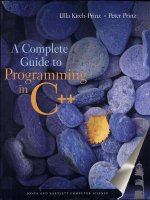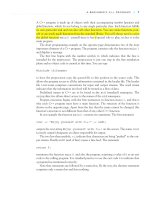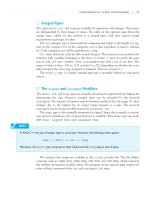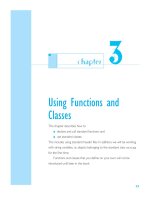A Complete Guide to Programming in C++ part 13 potx
Bạn đang xem bản rút gọn của tài liệu. Xem và tải ngay bản đầy đủ của tài liệu tại đây (217.54 KB, 10 trang )
THE FOR STATEMENT
■
99
ᮀ Initializing and Reinitializing
A typical loop uses a counter that is initialized, tested by the controlling expression and
reinitialized at the end of the loop.
Example: int count = 1; // Initialization
while( count <= 10) // Controlling
{ // expression
cout << count
<< ". loop" << endl;
++count; // Reinitialization
}
In the case of a for statement the elements that control the loop can be found in the
loop header. The above example can also be expressed as a for loop:
Example: int count;
for( count = 1; count <= 10; ++count)
cout << count
<< ". loop" << endl;
Any expression can be used to initialize and reinitialize the loop. Thus, a for loop has
the following form:
Syntax: for( expression1; expression2; expression3 )
statement
expression1
is executed first and only once to initialize the loop. expression2 is
the controlling expression, which is always evaluated prior to executing the loop body:
■ if expression2 is false, the loop is terminated
■ if expression2 is true, the loop body is executed. Subsequently, the loop is
reinitialized by executing expression3 and expression2 is re-tested.
You can also define the loop counter in expression1. Doing so means that the
counter can be used within the loop, but not after leaving the loop.
Example: for( int i = 0; i < 10; cout << i++ )
;
As this example illustrates, the loop body can be an empty statement. This is always the
case if the loop header contains all necessary statements. However, to improve readabil-
ity, even the empty statement should occupy a line of its own.
100
■
CHAPTER 6 CONTROL FLOW
// EuroDoll.cpp
// Outputs a table of exchange: Euro and US-$
#include <iostream>
#include <iomanip>
using namespace std;
int main()
{
long euro, maxEuro; // Amount in Euros
double rate; // Exchange rate Euro <-> $
cout << "\n* * * TABLE OF EXCHANGE "
<< " Euro – US-$ * * *\n\n";
cout << "\nPlease give the rate of exchange: "
" one Euro in US-$: ";
cin >> rate;
cout << "\nPlease enter the maximum euro: ";
cin >> maxEuro;
// Outputs the table
// Titles of columns:
cout << '\n'
<< setw(12) << "Euro" << setw(20) << "US-$"
<< "\t\tRate: " << rate << endl;
// Formatting US-$:
cout << fixed << setprecision(2) << endl;
long lower, upper, // Lower and upper limit
step; // Step width
// The outer loop determines the actual
// lower limit and the step width:
for( lower=1, step=1; lower <= maxEuro;
step*= 10, lower = 2*step)
// The inner loop outputs a "block":
for( euro = lower, upper = step*10;
euro <= upper && euro <= maxEuro; euro+=step)
cout << setw(12) << euro
<< setw(20) << euro*rate << endl;
return 0;
}
■
THE for STATEMENT (CONTINUED)
Sample program
THE FOR STATEMENT (CONTINUED)
■
101
Any of the three expressions in a for statement can be omitted, however, you must type
at least two semicolons. The shortest loop header is therefore:
Example: for(;;)
This statement causes an infinite loop, since the controlling expression is assumed to be
true if expression2 is missing. In the following
Example: for( ; expression; )
the loop header is equivalent to while(expression). The loop body is executed as
long as the test expression is true.
ᮀ The Comma Operator
You can use the comma operator to include several expressions where a single expression
is syntactically correct. For example, several variables can be initialized in the loop
header of a for statement. The following syntax applies for the comma operator
Syntax: expression1, expression2 [, expression3 ]
The expressions separated by commas are evaluated from left to right.
Example: int x, i, limit;
for( i=0, limit=8; i < limit; i += 2)
x = i * i, cout << setw(10) << x;
The comma operator separates the assignments for the variables i and limit and is
then used to calculate and output the value of x in a single statement.
The comma operator has the lowest precedence of all operators — even lower than
the assignment operators. This means you can leave out the parentheses in the above
example.
Like any other C++ expression, an expression containing the comma operator has a
value and belongs to a certain type. The type and value are defined by the last expression
in a statement separated by commas.
Example: x = (a = 3, b = 5, a * b);
In this example the statements in brackets are executed before the value of the product
of a * b is assigned to x.
102
■
CHAPTER 6 CONTROL FLOW
As long as the expression is true
statement
// tone.cpp
#include <iostream>
using namespace std;
const long delay = 10000000L;
int main()
{
int tic;
cout << "\nHow often should the tone be output? ";
cin >> tic;
do
{
for( long i = 0; i < delay; ++i )
;
cout << "Now the tone!\a" << endl;
}
while( tic > 0 );
cout << "End of the acoustic interlude!\n";
return 0;
}
■
THE do-while STATEMENT
Structogram for do-while
Sample program
THE DO-WHILE STATEMENT
■
103
In contrast to while and for loops, which are controlled by their headers, the do-
while
loop is controlled by its footer, i.e. the controlling expression is evaluated after
executing the first loop. This results in the loop body being performed at least once.
Syntax: do
statement
while( expression);
When a do-while loop is executed, the loop body is processed first. Only then is the
controlling expression evaluated. The loop body is iterated again if the result is
true, otherwise the loop is terminated.
The do-while loop must be followed by a semicolon.
✓
NOTE
ᮀ Nesting Loops
Loops can be nested, that is, the loop body can also contain a loop. The ANSI standard
stipulates a maximum depth of 256 nested loops.
The program on the opposite page outputs a number of tones with the number being
defined by user input.
The program contains two loops — one of which is nested in the other. Each time the
outer do-while loop is repeated a short break occurs. The break is caused by the inner
for loop where the variable i is incremented from 0 to the value of delay.
Text and a tone are subsequently output. The tone is generated by outputting the
control character BELL (ASCII code 7), which is represented by the escape sequence
\a.
Since a do-while statement is used, the program outputs a tone even if the user
types 0 or a negative number.
104
■
CHAPTER 6 CONTROL FLOW
true false
statement1 statement2
if (expression)
// if_else.cpp
// Demonstrates the use of if-else statements
#include <iostream>
using namespace std;
int main()
{
float x, y, min;
cout << "Enter two different numbers:\n";
if( cin >> x && cin >> y) // If both inputs are
{ // valid, compute
if( x < y ) // the lesser.
min = x;
else
min = y;
cout << "\nThe smaller number is: " << min << endl;
}
else
cout << "\nInvalid Input!" << endl;
return 0;
}
■
SELECTIONS WITH if-else
Structogram for the if-else statement
Sample program
Sample output for this program
Enter two different numbers:
7.5 5.7
The smaller number is: 5.7
SELECTIONS WITH IF-ELSE
■
105
The if-else statement can be used to choose between two conditional statements.
Syntax: if( expression )
statement1
[ else
statement2 ]
When the program is run, expression is first evaluated and the program control
branches accordingly. If the result is true, statement1 is executed and statement2
is executed in all other cases, provided an else branch exists. If there is no else and
expression is false, the control jumps to the statement following the if statement.
ᮀ Nested if-else Statements
As the program opposite illustrates, multiple if-else statements can be nested. But
not every if statement has an else branch. To solve the resulting problem, an else
branch is always associated with the nearest preceding if statement that does not have
an else branch.
Example: if( n > 0 )
if( n%2 == 1 )
cout << " Positive odd number ";
else
cout << "Positive even number";
In this example, the else branch belongs to the second if, as is indicated by the fact
that the statement has been indented. However, you can use a code block to redefine the
association of an else branch.
Example: if( n > 0 )
{ if( n%2 == 1 )
cout << " Positive odd number \n";
}
else
cout << " Negative number or zero\n";
ᮀ Defining Variables in if Statements
You can define and initialize a variable within an if statement. The expression is true if
converting the variable’s value to a bool type yields true. In this case the variable is
available within the if statement.
Example: if( int x = func() )
{ . . . } // Here to work with x.
The return value of the function, func(), is used to initialize the variable x. If this
value is not 0, the statements in the next block are executed. The variable x no longer
exists after leaving the
if statement.
106
■
CHAPTER 6 CONTROL FLOW
if(expression)
if(expression)
if(expression)
true false
true
true false
false
statement1
statement(n) statement(n+1)
statement2
. . .
// speed.cpp
// Output the fine for driving too fast.
#include <iostream>
using namespace std;
int main()
{
float limit, speed, toofast;
cout << "\nSpeed limit: ";
cin >> limit;
cout << "\nSpeed: ";
cin >> speed;
if( (toofast = speed – limit ) < 10)
cout << "You were lucky!" << endl;
else if( toofast < 20)
cout << "Fine payable: 40, Dollars" << endl;
else if( toofast < 30)
cout << "Fine payable: 80, Dollars" << endl;
else
cout << "Hand over your driver's license!" << endl;
return 0;
}
■
Else-if CHAINS
Structogram for an else-if chain
Sample program
ELSE-IF CHAINS
■
107
ᮀ Layout and Program Flow
You can use an else-if chain to selectively execute one of several options. An else-
if
chain implies a series of embedded if-else statements whose layout is normally as
follows:
if ( expression1 )
statement1
else if( expression2 )
statement2
.
.
.
else if( expression(n) )
statement(n)
[ else statement(n+1)]
When the else-if chain is executed, expression1, expression2, are
evaluated in the order in which they occur. If one of the expressions proves to be true,
the corresponding statement is executed and this terminates the else-if chain.
If none of the expressions are true, the else branch of the last if statement is exe-
cuted. If this else branch is omitted, the program executes the statement following the
else-if chain.
ᮀ The Sample Program
The program opposite uses an else-if chain to evaluate the penalty for driving too fast
and outputs the fine on screen.
The speed limit and the actual speed are read from the keyboard. If the user types 60
as the speed limit and 97.5 as the actual speed, the first three expressions are not true,
and the last else branch is executed. This outputs the message "Hand over your
driver's license!"
on a new line.
108
■
CHAPTER 6 CONTROL FLOW
true false
expression1 expression2
expression
// greater.cpp
#include <iostream>
using namespace std;
int main()
{
float x, y;
cout << "Type two different numbers:\n";
if( !(cin >> x && cin >> y) ) // If the input was
{ // invalid.
cout << "\nInvalid input!" << endl;
}
else
{
cout << "\nThe greater value is: "
<< (x > y ? x : y) << endl;
}
return 0;
}
■
CONDITIONAL EXPRESSIONS
Structogram for a conditional expression
Sample program
Sample output for this program
Type two different numbers:
173.2
216.7
The greater value is: 216.7









